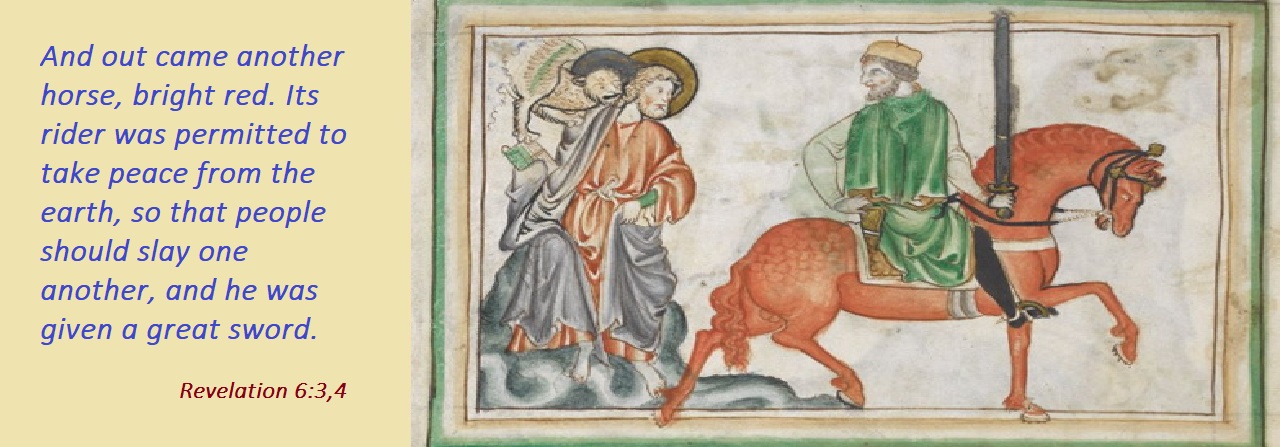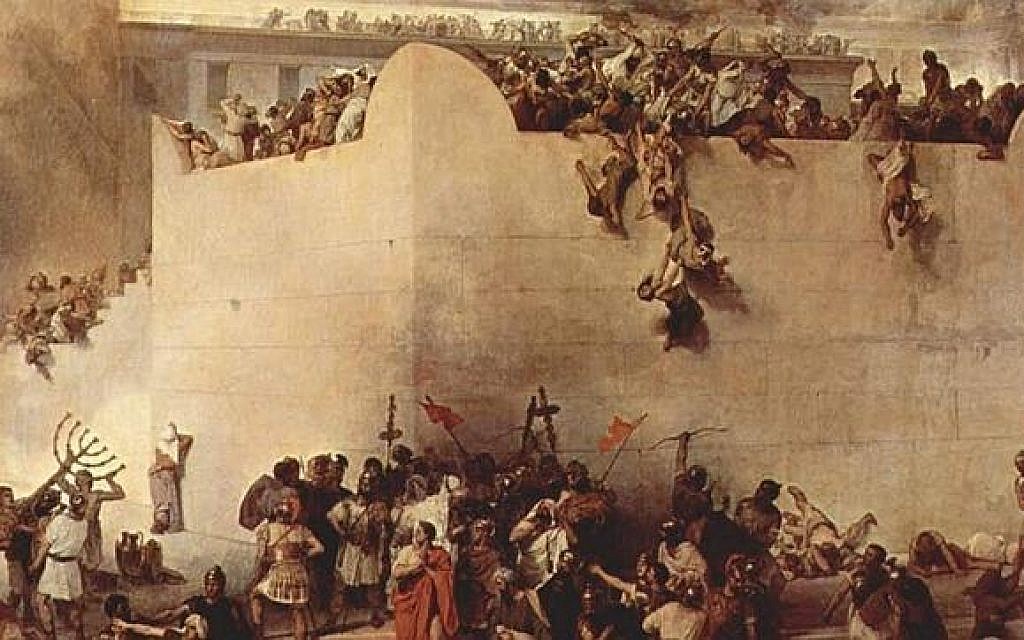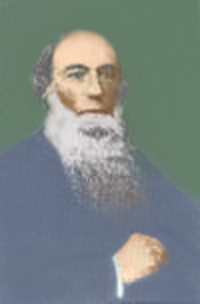
Biblical Evidence for the 1st Century Return of Christ
… parousiafulfilled.com
In Part 1, we examined missing historical events in the Book of Revelation; the theme of the book; and the fulfillment of the vision of the beast from the sea. In Part 2, we look at the 1st Century fulfillment of the scroll vision.
Although major historical events are unreported in the Apocalypse, they were prophesied and eventually fulfilled in the 1st Century AD. Gentry enlarges on this theme in his excellent book: “Before Jerusalem Fell”. 1 In this essay we will examine the vision of the scroll with six seals, and see how it was fulfilled.
2.1 “TAKE PEACE FROM THE EARTH, SO THAT PEOPLE SHOULD SLAY ONE ANOTHER”
The Apocalypse warns that:
“all tribes of the earth will wail on account of him”. (Revelation 1:7b)
We noted in Part 1 that this passage refers to: “all the descendants of Jacob in the land of Israel”, and, furthermore, it echoes what Jesus said to his disciples on the Mount of Olives:
“… all the tribes of the earth will mourn… “. (Matthew 24:30)
Why will they mourn? Because there will be war and strife in the land of Judea, at the parousia return of Christ.
The First Seal

In chapter 6, John reveals the vision of the scroll with seven seals:
‘Now I watched when the Lamb opened one of the seven seals, and I heard one of the four living creatures say with a voice like thunder, “Come!” And I looked, and behold, a white horse! And its rider had a bow, and a crown was given to him, and he came out conquering, and to conquer.’. (Revelation 6:1,2)
The word “crown” is “στέφανος” (stephanos) in the original Greek, which means “the victor’s crown”, “a crown of glory” or “a token of public honor”. Vine’s Expository Dictionary says: “It was woven as a garland of oak, ivy, parsley, myrtle, or olive, or in imitation of these in gold.” 2 The same Greek word is used in the gospels to denote the “crown” of thorns placed on Jesus head (Matthew 27:29, Mark 15:17, John 19:2,5).
The rider on a white horse is identified in another passage in chapter 19:
“Then I saw heaven opened, and behold, a white horse! The one sitting on it is called Faithful and True, and in righteousness he judges and makes war. His eyes are like a flame of fire, and on his head are many diadems [Gk: διαδήματα : diademata : kingly crowns], and he has a name written that no one knows but himself. He is clothed in a robe dipped in blood, and the name by which he is called is The Word of God… On his robe and on his thigh he has a name written, King of kings and Lord of lords.”. (Revelation 19:11-13,16)
Most scholars believe that “the rider on a white horse”, in both Revelation 6 and 19, is none other than the victorious Christ. First he is portrayed wearing a victor’s crown (stephanos), and later he is portrayed wearing many kingly crowns (diademata), because he has received a kingdom from the Father, and is now the “King of kings and Lord of lords”.
The Second Seal
John sees the Lamb opening another seal on the scroll:
“When he opened the second seal, I heard the second living creature say, “Come!” And out came another horse, bright red. Its rider was permitted to take peace from the earth, so that people should slay one another, and he was given a great sword.’. (Revelation 6:3,4)
The words “the earth” in the original Greek are “τῆς γῆς” (tes ges), which means “the land”. The passage is warning that peace will end, and war will break out across the land of Judea. (NOT everywhere on planet Earth).
Russell I explains that the rider on a red horse represents an army waging war in the land of Judea. The sword is symbolic of great carnage and bloodshed. The phrase: “people… slay one another” indicates internecine fighting and civil war amongst the people in Judea. 3
Fulfillment:
This prophetic vision was COMPLETELY FULFILLED during the Jewish War against Rome, which began with a violent Jewish uprising against Roman Governor, Gessius Florus in AD 66. In retaliation, a large Roman army, under the command of General Vespasian, was sent to put down the revolt. Arriving in Galilee in AD 67, Vespasian officially declared war and conquered the land. The war lasted some 42 months, until late AD 70, when Vespasian’s son, Titus, laid siege to Jerusalem and utterly destroyed it. At the same time, there was continuous civil war among various Jewish factions, so that “peace was taken from the land” and it was thoroughly polluted with bloodshed.
For more information on the Jewish War, read my article “Nature of Fulfillment”.
2.2 “KILL WITH THE SWORD, FAMINE, PESTILENCE AND WILD ANIMALS”
The Third Seal
As the vision proceeds, John sees the Lamb open another seal:
‘When he opened the third seal, I heard the third living creature say, “Come!” And I looked, and behold, a black horse! And its rider had a pair of scales in his hand. And I heard what seemed to be a voice in the midst of the four living creatures, saying, “A quart of wheat for a denarius, and three quarts of barley for a denarius, and do not harm the oil and wine!”’. (Revelation 6:5,6)
War and violence soon leads to massive food shortages, and the price of wheat and barley soars to exhorbitant levels: one “denarius” (a day’s pay) for a quart of wheat or three quarts of barley.
The Fourth Seal
The troubles increase:
‘When he opened the fourth seal, I heard the voice of the fourth living creature say, “Come!” And I looked, and behold, a pale horse! And its rider’s name was Death, and Hades followed him. And they were given authority over a fourth of the earth, to kill with sword and with famine and with pestilence and by wild beasts of the earth.’. (Revelation 6:7,8)
There is now widespread death, followed by Hades (place of departed spirits). A quarter of the populace is killed by four divine plagues: sword, famine, pestilence and wild beasts; much like the divine plagues threatened in many Old Testament scriptures. Consider the following:
“For thus says the Lord GOD: How much more when I send upon Jerusalem my four disastrous acts of judgment, sword, famine, wild beasts, and pestilence, to cut off from it man and beast!”. (Ezekiel 14:21)
~~~~~~~~~~~~~~~~~
“I will visit you with panic, with wasting disease and fever… you shall sow your seed in vain, for your enemies shall eat it… I will let loose the wild beasts against you… I will bring a sword upon you…”. (Leviticus 26:16,22,25)
~~~~~~~~~~~~~~~~~
“The LORD will make the pestilence stick to you… wasting disease and with fever, inflammation and fiery heat, and with droughts and with blight and with mildew. … “ (Deuteronomy 28:21,22,)
Fulfillment:
Ancient historians recount that these four plagues actually occurred in Jerusalem during the Jewish War and the Siege of Jerusalem. Farmlands and orchards were burned or trampled by Roman armies, food was devastated, and vast granaries and storehouses were burned to the ground. These storehouses were overflowing with corn and other food, but rival gangs of Jewish zealots deliberately burned them down, rather than risk them falling into the hands of civilians or other zealot gangs. They murdered anyone who opposed them, including innocent people who opposed war, plus anyone trying to desert, plus even the priests offering sacrifices in the temple.

The resulting famine was so severe, according to Flavius Josephus II , that: “Many there were indeed who sold what they had for one measure; it was of wheat, if they were of the richer sort; but of barley, if they were poorer.”. 4 “The famine… devoured the people by whole houses and families; the upper rooms were full of women and children that were dying by the famine; and the lanes of the city were full of the dead bodies of the aged;”. 5 Fathers stole food out of their children’s mouths, and vice versa. People resorted to eating cow’s dung and rubbish from the sewers. The suffering and despair was so great, that even cannibalism was witnessed. Josephus recounts that one eminent noblewoman was so seized with hunger and anger, that she roasted and devoured her own child. 6
Josephus says that “no fewer than six hundred thousand [dead carcases] were thrown out at the gates” 7 ; and “thus did the miseries of Jerusalem grow worse and worse every day, and the seditious were still more irritated by the calamities they were under, even while the famine preyed upon themselves, after it had preyed upon the people. And indeed the multitude of carcasses that lay in heaps one upon another was a horrible sight, and produced a pestilential stench”. 8
Those who somehow managed to survive war and famine and pestilence, inside the city, were eventually taken away in chains by the Romans. Josephus recounts that “Titus also sent a great number into the provinces, as a present to them, that they might be destroyed upon their theatres, by the sword and by the wild beasts”. 9 Thus, the vision of the third and fourth seals was COMPLETELY FULFILLED.
2.3 ‘CALLING ON THE MOUNTAINS AND ROCKS “FALL ON US AND HIDE US”.’
The Fifth Seal
Another seal is opened in heaven:
‘When he opened the fifth seal, I saw under the altar the souls of those who had been slain for the word of God and for the witness they had borne. They cried out with a loud voice, “O Sovereign Lord, holy and true, how long before you will judge and avenge our blood on those who dwell on the earth?” Then they were each given a white robe and told to rest a little longer [Gk: ἔτι χρόνον μικρόν : epi chronon micron : yet A LITTLE TIME], until the number of their fellow servants and their brothers should be complete, who were to be [Gk: μέλλοντες : mellontes : ABOUT TO BE] killed as they themselves had been.’. (Revelation 6:9-11)
God hears the cries of the righteous martyrs and tells them to “rest a little longer”, because more of their brothers are “ABOUT TO BE” killed. This event was imminent, NOT something delayed for thousands of years!
As Russell 10 notes: “Our Lord forewarned the Jews that ‘upon them should come all the righteous blood shed upon the earth, from the blood of righteous Abel, unto the blood of Zacharias son of Barachaias, whom ye slew between the temple and the altar. Verily I say unto you, All these things shall come upon this generation’ (Matt. xxiii. 35, 36).”
“He forewarned His disciples that some of them would fall victims to Jewish enmity: ‘Then shall they deliver you up to be afflicted, and shall kill you’ (Matt. xxiv. 9).”
“Our Lord also declared that Jerusalem was deepest in the guilt of shedding innocent blood: she was the murderess of the prophets; and upon her the most signal punishment was to fall (Matt. xxiii. 31-39).”
Jesus promised that God would “give justice to his elect… he will give justice to them speedily”. (Luke 8:7,8)
The Sixth Seal
The vision continues with a sixth seal:
“When he opened the sixth seal, I looked, and behold, there was a great earthquake, and the sun became black as sackcloth [Gk: σάκκος τρίχινος : sakkos trichinos : sackcloth made of hair], the full moon became like blood, and the stars of the sky fell to the earth as the fig tree sheds its winter fruit when shaken by a gale. The sky vanished like a scroll that is being rolled up, and every mountain and island was removed from its place.”. (Revelation 6:12-14)
These events echo the Jesus’ words, on the Mount of Olives (Matthew 24), where he prophesies:
“there will be famines and earthquakes in various places”. (Matthew 24:7)
“the sun will be darkened, and the moon will not give its light, and the stars will fall from heaven, and the powers of the heavens will be shaken”. (Matthew 24:29)
As noted in Part 1, the Apocalypse uses prophetic visions, symbols and figurative language… “ gorgeous symbolical imagery” (Russell 11 ), to convey the awesome gravity and significance of divine judgements.
John Owen notes that: “… through all the prophets, heaven, sun, moon, stars and the like are taken for governments, governors, dominions in political states, as Isa. xiv 12-15; Jer. xv. 9, li. 25” (Bray 12 ).
John L Bray 13 wrote that: “This is prophetic language. When the rulers of the nation which God destroyed passed away, it was said the heavens passed away. … in the New Testament we are thinking of the nation of Israel ‐ the only nation under consideration in the whole New Testament. When the heavens passed away, it was Israel which passed away.”
Thus we see that vision of the sixth seal is describing the utter destruction and upheaval of everything in Israel (NOT the destruction of planet Earth and the universe). [Hint: stars are huge and cannot literally “fall to earth” like leaves from a tree.]
The vision of the sixth seal then describes the impact of all this upheaval on the inhabitants of “the land”:
‘Then the kings of the earth [Gk: βασιλεῖς τῆς γῆς : basileis tes ges : kings of the land] and the great ones and the generals and the rich and the powerful, and everyone, slave and free, hid themselves in the caves and among the rocks of the mountains, calling to the mountains and rocks, “Fall on us and hide us from the face of him who is seated on the throne, and from the wrath of the Lamb, for the great day of their wrath has come, and who can stand?”’. (Revelation 6:15-17)
As Russell 5 explains, the scene here is one of: “a country abounding in rocky caverns and hiding-places, which, it is well known, are characteristic of Judea. The limestone hills of that country are literally honeycombed with caverns, … the dens of robbers and the shelter of fugitives from time immemorial.”
Josephus informs us that, when Jerusalem fell to the Romans, the last survivors of the siege fled into the rocky caverns underneath the city and its mountains:
“the last hope which supported the tyrants and that crew of robbers who were with them, was in the caves and caverns underground, whither, if they could once fly, they did not expect to be searched for; but endeavoured, that after the whole city should be destroyed, and the Romans gone away, they might come out again , and escape from them.” 14
Even Simon, one of the zealot leaders, “took the most faithful of his friends with him … and let himself and them all down into a certain subterraneous cavern that was not visible above the ground” and advanced through it as far as the ancient excavations permitted. 15
Just as the Apocalypse foretold, “kings of the land… great ones… generals… rich and powerful… slave and free, hid themselves in the caves and among the rocks of the mountains”.
Fulfillment:
History records that all the drama and tragedy of the sixth seal was completely fulfilled in Judea during the AD 70 siege and destruction of Jerusalem. The existing religious, political and social order of Old Covenant Israel (“sun, moon and stars”) was completely shattered and destroyed, and the last act of the vile tyrants and robbers was to dig themselves down into the caverns, under the rocks and mountains, in a vain attempt to escape the wrath of God.
Part 2 of this essay has clearly demonstrated, from scripture and ancient history, that the massive upheaval, bloodshed and destruction prophesied in the Scroll Vision, was fulfilled during the Jewish War and the Siege of Jerusalem (AD 66-70). Together with the findings of Part 1, it seems reasonable to conclude that the Date of Revelation is well before AD 66, and likely around AD 62 or 63, just before the Neronic persecution wiped out thousands of Christians throughout the Roman Empire.
Read more on the prophesied “imminence” of the parousia (“Second Coming”) of Christ in these articles:
This article is not an exhaustive survey of historical authorities and sources on this topic. Truth‐seekers will want to undertake further reading, and I recommend the following scholarly works:

I… James Stuart Russell (1816-1895) was a minister in the Congregational Church at Great Yarmouth, Tottenham, Edmonton, and Bayswater. He held to a past fulfillment of the Second Advent and in 1878 he published a book on this subject, originally entitled “The Parousia: The New Testament Doctrine of Our Lord’s Second Coming”.
Photo of J S Russell: author of “The Parousia”. Photograph, colorized by Virgil Vaduva

II… Flavius Josephus (circa AD 37‐100) was a Jewish priest, scholar, historian and active participant in the final decades of ancient Israel (Judea). He was also an aristocrat, a Pharisee, a military commander and politician, who wrote extensive accounts of his life and Jewish history, including a detailed account of the Jewish War against Rome. He was an eyewitness of the horrors and abominations (which he tried to stop) during the Roman siege of Jerusalem (AD 70).
Flavius Josephus
Before Jerusalem Fell by Gentry, Kenneth L., Th. D., Victorious Hope Publishing, Fountain Inn, South Carolina, 3rd Ed. 1998.
Final Decade Before the End: Jewish and Christian History Just Before the Jewish Revolt by Stevens, Edward E. International Preterist Association, Inc. Bradford, PA 2014.
Fundamental Wesleyan Commentary on Revelation by Reasoner, Victor P., Fundamental Wesleyan Publishers, Evansville, IN 2005.
Josephus: The Complete Works, translated by Whiston, William. A.M., Thomas Nelson Publishers, Nashville, TN 1998.
The Parousia: The New Testament Doctrine of Our Lord’s Second Coming by Russell, James Stuart, International Preterist Association, Bradford PA, 2003. (Originally published by T. Fisher Unwin, London, 1887).
NB: “Unless Otherwise indicated, all Scriptures are from the Holy Bible, English Standard Version, copyright © 2001, 2007, 2011, 2016 by Crossway Bibles, a division of Good News Publishers. Used by permission. All rights reserved.”
1…“Before Jerusalem Fell”, Gentry, pp240-256.
2…“Vine’s Expository Dictionary of New Testament Words”, Strong’s Number: g4735. Viewed 30 September 2020 at: https://www.blueletterbible.org/lang/lexicon/lexicon.cfm?Strongs=G4735&t=YLT
3…“The Parousia”, J. Stuart Russell, pp388-390.
4…“Wars of the Jews”, Josephus, 5‐10‐2.
5…ibid. 5.12.3.
6…ibid. 6.3.4.
7…ibid. 5.13.7.
8…ibid. 6.1.1.
9…ibid. 6.9.2.
10…Russell, op. cit. p394.
11…ibid. p399.
12…“Shaking and Translating of Heaven and Earth”, John Owen, vol. 8, 255, a sermon preached on April 19, 1649. (Quoted in Matthew 24 Fulfilled, by Bray, John L., p269.)
13…“Matthew 24 Fulfilled”, John L. Bray, p282.
14…Josephus, op. cit. 6.7.3.
15…ibid. 7.2.2.
copyright © 2019‐2023 Kenneth Higgs ‐ ParousiaFulfilled.com ‐ v2.01